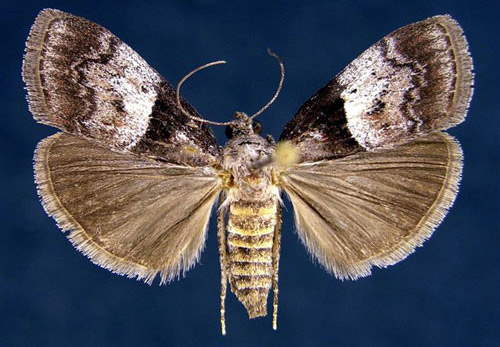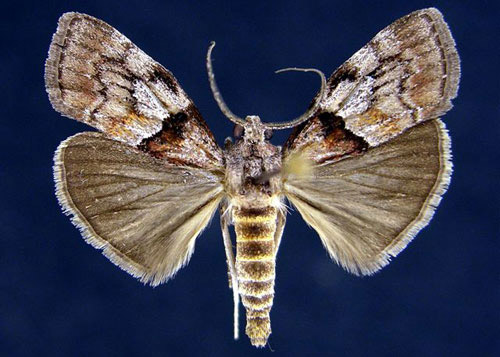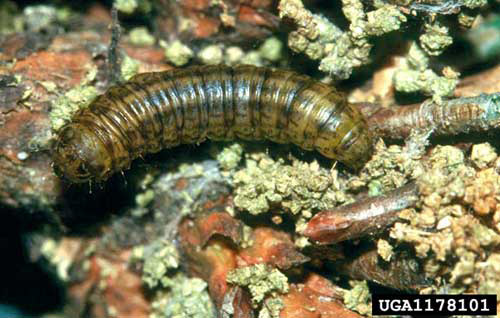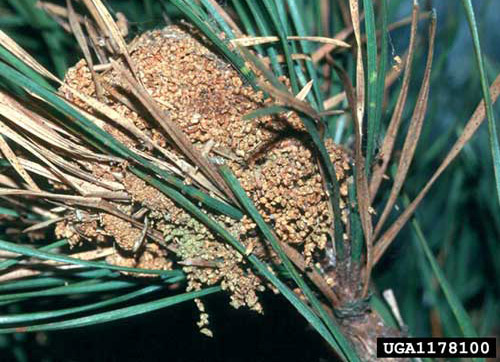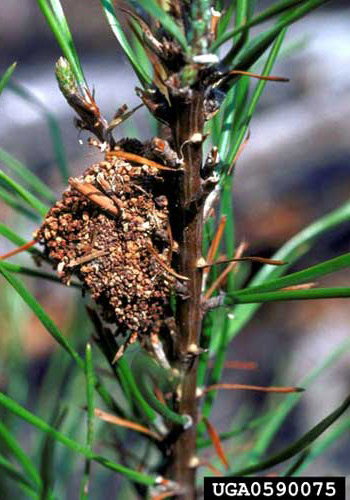common name: pine webworm
scientific name: Pococera robustella (Zeller) (Insecta: Lepidoptera: Pyralidae)
Introduction - Distribution - Description - Biology - Hosts - Recognition of Damage - Management - Selected References
Introduction (Back to Top)
The pine webworm, Pococera robustella (Zeller), is a common defoliator of pines in the eastern United States. Infestations commonly occur on young (one to two-year old) pine seedlings, but larger seedlings and branches of mature pines can also become infested. The conspicuous larval nests of the pine webworm can substantially reduce the aesthetic and commercial value of pines grown as Christmas trees or ornamentals (Wallesz and Benjamin 1960). Although severe defoliation can kill first year pine seedlings (Merkel and Hertel 1976), defoliation in plantations and natural forests rarely results in mortality or significant damage, with impact generally limited to reduced seedling growth on stems less than 0.6 m tall (Hertel and Benjamin 1977, USDA Forest Service 1989).
Figure 1. Adult female pine webworm, Pococera robustella (Zeller). Photograph by Jim Vargo.
Distribution (Back to Top)
The pine webworm occurs in southern Canada and throughout most of the eastern half of the United States from New England to Florida and west to Wisconsin and Minnesota (USDA Forest Service 1989; Johnson and Lyon 1991).
Description (Back to Top)
Adult: The adult is a small gray to brownish moth with a of wingspan 22 to 25 mm. The basal third of the forewing is dark gray to black (paler at extreme base), with the remainder of the forewing pale gray, and becoming darker grey toward outer half. The hind wings are brown with darker shading toward outer margin (Wallesz and Benjamin 1960, USDA Forest Service 1989).
Figure 2. Adult male pine webworm, Pococera robustella (Zeller). Photograph by Jim Vargo.
Egg: The egg is 1 mm long, ovoid, flattened, and cream to bright yellow in color.
Larva: The larva is 13 to 18 mm long when mature. The body is light brown with darker longitudinal stripes, while the head is light brown with black markings.
Figure 3. Larva of the pine webworm, Pococera robustella (Zeller). Photograph by Connecticut Agricultural Experiment Station Archives, www.forestryimages.org.
Pupa: The pupal case is a flattened ovoid cocoon measuring 12 x 8 mm, covered with packed sand grains and lined with yellow silk.
Biology (Back to Top)
The number of pine webworm generations per year varies from three in northeast Florida (Hertel and Benjamin 1979) to one in the northern part of the insect's range (Wallesz and Benjamin 1960). In Florida, adults can be found from April to October, with peak trap captures in June. Female moths lay small masses of one to 10 overlapping eggs on the flat surface of host needles. Young larvae (1st through 3rd instars) mine the needles, whereas older larvae (4th through 6th instars, and occasionally 2nd or 3rd instars) construct and share a common frass nest on a branch or main stem. Larvae either partially or completely exit the nest to clip needles that they bring back into the nest to consume. Mature larvae eventually move to the ground and spin cocoons in which they pupate (Hertel and Benjamin 1979).
Figure 4. Frass nest of older larvae of the pine webworm, Pococera robustella (Zeller). Photograph by Connecticut Agricultural Experiment Station Archives, www.forestryimages.org.
Hosts
(Back to Top)
Reported hosts include the following pine species:
- eastern white (Pinus strobus L.),
- jack (Pinus banksiana Lamb.),
- loblolly (Pinus taeda L.),
- longleaf (Pinus palustris Mill.),
- pitch (Pinus rigida Mill.),
- red (Pinus resinosa Ait.),
- sand (Pinus clausa (Chapm. ex Engelm.) Vasey ex Sarg.),
- Scots (Pinus sylvestris L.),
- shortleaf (Pinus echinata Mill.),
- slash (Pinus elliotii Engelm.), and
- Virginia pine (Pinus virginiana Mill.)
(Wallesz and Benjamin 1960, Merkel and Hertel 1976).
Recognition of Damage (Back to Top)
Pine webworms produce a conspicuous globular mass of brown fecal pellets and needles held together with silk webbing. This frass nest is typically 5 to 15 cm long, with its size depending on the number of larvae contributing to its formation. Affected seedlings and shoots may also exhibit missing foliage and stubs of partially eaten needles.
Figure 5. Frass nest of older larvae of the pine webworm, Pococera robustella (Zeller). Photograph by Robert L. Anderson, USDA Forest Service; www.forestryimages.org.
Management (Back to Top)
In forests, the pine webworm is not a serious pest and typically does not warrant control. Populations of the pine webworm are regulated in part by its natural enemies, including several species of parasitic wasps (Hymenoptera: Eulophidae, Braconidae, Chalcididae, Ichneumonidae), parasitic flies (Diptera: Tachinidae), assassin bugs (Hemiptera: Reduviidae), and birds (Wallesz and Benjamin 1960, Hertel and Benjamin 1979).
Studies examining possible relationships between site preparation intensity and pine webworm infestation levels have been inconclusive (Hertel and Benjamin 1977). Frass nests containing larvae can be hand picked and destroyed. Removing vacated nests may improve aesthetics, but it provides no population control. Pine webworm larvae may be killed by spraying occupied nests with an approved insecticide. If infestation levels are excessive and chemical control is desired, consult your local county cooperative extension service for current insecticide recommendations.
Selected References (Back to Top)
- Hertel GD, Benjamin DM. 1977. Intensity of site preparation influences on pine webworm and tip moth infestations on pine seedlings in north-central Florida. Environmental Entomology 6: 118-122.
- Hertel GD, Benjamin DM. 1979. Biology of the pine webworm in Florida slash pine plantations. Annals of the Entomological Society of America.72: 816-819.
- Johnson WT, Lyon HH. 1991. Insects that Feed on Trees and Shrubs. 2nd edition, revised. Cornell University Press, Ithaca, NY. 560 pp.
- Merkel EP, Hertel GD. 1976. Pine tip moth and pine webworm control with carbofuran in north Florida. USDA Forest Service Research Note SE-236, Southeastern Forest Experiment Station, Asheville, NC. 6 pp.
- USDA Forest Service. 1989. Insects and diseases of trees in the South. Protection Report R8-PR 16. USDA Forest Service, Southern Region, Atlanta, GA. 98 pp.
- Wallesz DP, Benjamin DM. 1960. The biology of the pine webworm, Tetralopha robustella, in Wisconsin. Journal of Economic Entomology 53: 587-589.
